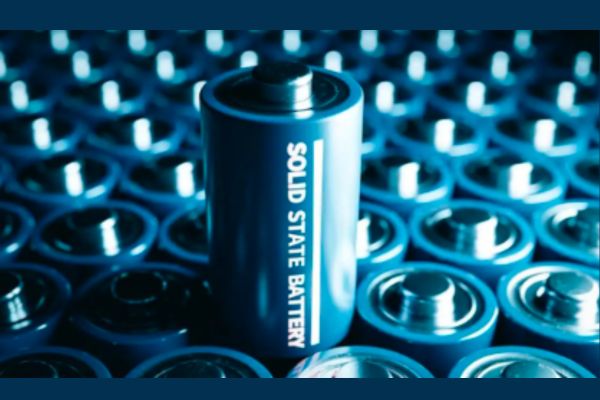Solid-state batteries (SSBs) are heralded as a transformative innovation in energy storage (ES), offering numerous advantages over traditional lithium-ion batteries. Their higher energy density allows for smaller, lighter batteries that can store more energy, making them ideal for electric vehicles (EVs), consumer electronics, electric Vertical Take-Off and Landing (eVTOL) & drones, and robotics. SSBs also boast a longer lifespan, faster charging times, and improved safety due to the absence of flammable liquid electrolytes. These benefits position SSBs as a cornerstone of the next generation of battery technologies, with the potential to reshape industries reliant on ES, as analyzed by IDTechEx’s report “Solid-State and Polymer Batteries 2025-2035: Technology, Forecasts, Players“.

Global commercialization progress
The journey toward commercializing SSBs has gained significant momentum in recent years, driven by advancements in materials science, strategic partnerships, and government support. Companies like QuantumScape and Solid Power have established pilot production lines to refine manufacturing processes. For instance, QuantumScape has reported progress in scaling up its lithium-metal SSB technology, while Solid Power has opened a pre-pilot line to develop EV-specific cells. Major automakers such as Toyota and Volkswagen are also heavily invested in SSB research, with Toyota planning to release an SSB-powered EV by 2027.
Globally, governments are playing a pivotal role in accelerating commercialization. The U.S. National Blueprint fosters SSB innovation through production goals, while the Inflation Reduction Act incentivizes domestic manufacturing and adoption via tax credits and supply chain support. In Japan, the Libtec consortium is fostering innovation in SSB technology, while South Korea’s major battery manufacturers – SK Innovation, LG Chem, and Samsung SDI – are collaborating on next-generation battery research. Europe is also advancing rapidly, with initiatives focused on sustainable material sourcing and recycling to meet Green Deal targets.
These efforts are complemented by private-sector investments in pilot lines and gigafactories dedicated to scaling up production.
For instance, Blue Solutions has been manufacturing polymer SSBs for a long time, offering SSB products for EVs. ProLogium Technology operates the world’s first gigafactory for solid-state lithium ceramic batteries in Taoyuan, Taiwan. This facility began supplying automakers in 2024 and features innovative manufacturing technologies, such as continuous wet coating for solid electrolytes. The gigafactory has achieved production efficiency 2.6 times greater than ProLogium’s earlier facilities, with doubled assembly speed and reduced costs. Samsung SDI has constructed a pilot production line, known as “S-Line,” at its R&D Center in Suwon, South Korea. This facility focuses on developing advanced solid-state battery technologies, including cathode and solid electrolyte production systems. While still in the pilot phase, Samsung SDI plans to achieve mass production of all-solid-state batteries by 2027. ION Storage Systems commissioned its first pilot production line in Maryland in 2024. Initially, this facility is expected to produce 1 MWh of battery cells, scaling up to 10 MWh by early 2025 and aiming for 500 MWh capacity by 2028. The company’s anode-less technology simplifies the manufacturing process. Solid Power operates a roll-to-roll production line in Colorado, producing prototype all-solid-state lithium metal batteries. Strategic partners like BMW are currently validating these prototypes. Solid Power plans to scale up its operations and achieve full mass production by 2030. Hyundai Motor Company is building a demonstration production line for solid-state batteries and plans to trial-produce electric vehicles equipped with these batteries by 2025. Partial mass production is expected by 2027, with full-scale operations targeted for 2030.
The rapid pace of innovation suggests that many of these obstacles might be addressed within this decade.
Implications for supply chain reshuffling
The commercialization of SSBs is poised to impact global supply chains significantly. Conventional lithium-ion battery manufacturing has been dominated by East Asia, with Japan, China and South Korea playing a significant role. US and European countries are competing in the race, shifting the added values away from East Asia and building battery manufacturing close to the application market. New material/component selection and change of manufacturing procedures indicate a reshuffle of the battery supply chain, such as lithium metal anode, silicon anode, and solid-state electrolyte. From both a technology and business point of view, the development of solid-state batteries has become part of the next-generation battery strategy. It has become a global game with regional interests and governmental support. Opportunities will be available for new materials, components, systems, manufacturing methods and know-how.
Recycling will play a crucial role in mitigating these challenges. As EV adoption grows, end-of-life batteries will provide a valuable source of recycled materials for new SSB production. Policymakers and industry leaders must collaborate to establish robust recycling infrastructure and regulations to ensure a sustainable supply chain.
IDTechEx has launched the report “Solid-State and Polymer Batteries 2025-2035: Technology, Forecasts, Players”, offering technology benchmarking & analysis, market estimation & forecast, player activity tracking & evaluation, and supply chain establishment & security on solid-state battery R&D, commercialization and deployment.
Key takeaways from this report:
- Overview of lithium-ion batteries, various solid-state battery technologies, analysis and benchmarking
- Technology and manufacturing timelines, roadmaps
- Manufacturing methods
- Market analysis and forecasts
- Cost and energy density analysis
- Solid-state battery hype vs hope analysis
- Player activity tracking & evaluation
- Supply chain analysis
- Regulations and recycling













